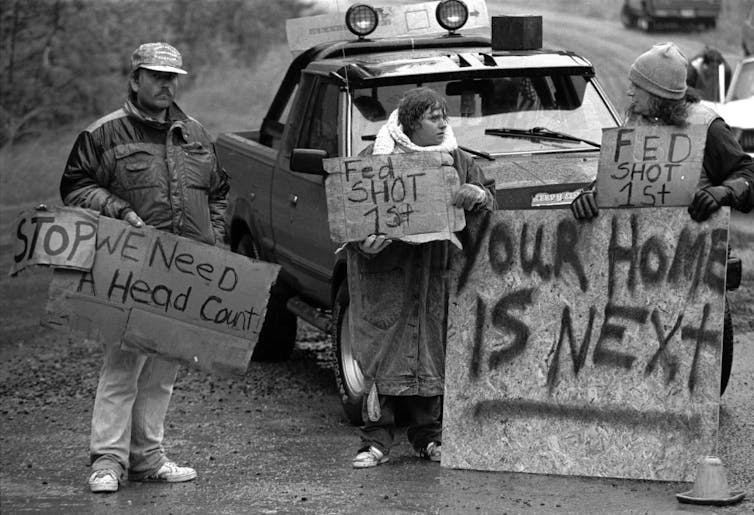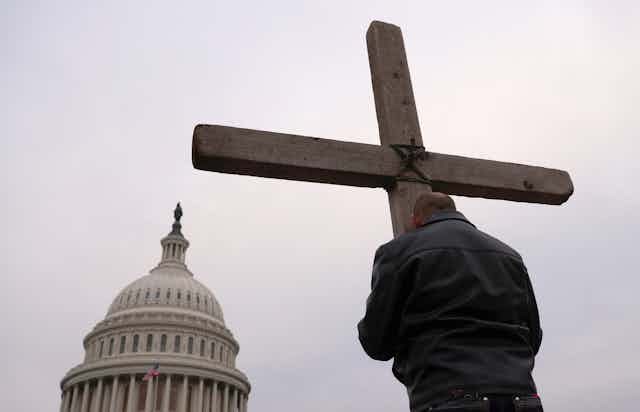An updated version of this article was published on Aug. 5, 2022. Read it here.
Christian imagery loomed large on Jan. 6 as the “Stop the Steal” rally morphed into a mob siege. A group of Trump supporters prayed around a large wooden cross, and others carried “Jesus saves” signs and yelled “shout if you love Jesus” as they occupied the Capitol building.
Meanwhile the Christian flag – the red, white and blue emblem designed by a New York City Sunday school teacher in 1887 to unite and symbolize Christians worldwide – was one of the flags carried through the Capitol.
This blending of Christian imagery with Trump flags put Christian nationalism, the often militarized fusing of Christianity and American identity, on display during one of America’s darkest days.
As someone who has written about white nationalism during the Trump presidency, I find this somewhat unsurprising.
As scholars of religion Andrew Whitehead and Samuel L. Perry argue in their book “Taking Back America for God,” Christian nationalism is predominant in Trump support.
Perry and Whitehead describe the movement as “as ethnic and political as it is religious,” noting that it takes in assumptions of white supremacy.
Christian nationalism is not always violent, but Christian nationalist violence has been a presence during the Trump administration. More broadly it has been on the rise over the past few decades.
From siege to militia buildup
Violence perpetrated by Christian nationalists has manifested in two primary ways in recent decades. The first is through their involvement in militia groups; the second is seen in attacks on abortion providers.
The catalyst for the growth of militia activity among contemporary Christian nationalists stems from two events: the 1992 Ruby Ridge standoff and the 1993 siege at Waco.
At Ruby Ridge, former U.S. Army Green Beret Randy Weaver engaged federal law enforcement in an 11-day standoff at his rural Idaho cabin over charges relating to the sale of sawed-off shotguns to an ATF informant investigating Aryan Nation white supremacist militia meetings.

Weaver ascribed to the Christian Identity movement, which emphasizes adherence to Old Testament laws and white supremacy. Christian Identity members believe in the application of the death penalty for adultery and LBGTQ relationships in accordance with their reading of some biblical passages.
During the standoff, Weaver’s wife and teenage son were shot and killed before he surrendered to federal authorities.
In the Waco siege a year later, cult leader David Koresh and his followers entered a standoff with federal law enforcement at the group’s Texas compound, once again concerning weapons charges. After a 51-day standoff, federal law enforcement laid siege to the compound. A fire took hold at the compound in disputed circumstances leading to the deaths of 76 people, including Koresh.
The two events spurred a nationwide militia buildup. As sociologist Erin Kania argues, “Ruby Ridge and Waco confrontations drove some citizens to strengthen their belief that the government was overstepping the parameters of its authority. … Because this view is one of the founding ideologies of the American Militia Movement, it makes sense that interest and membership in the movement would sharply increase following these standoffs between government and nonconformists.”
Distrust of the government blended with strains of Christian fundamentalism, bringing together two groups with formerly disparate goals.
Christian nationalism and violence
Christian fundamentalists and white supremacist militia groups both figured themselves as targeted by the government in the aftermath of the standoffs at Ruby Ridge and Waco. As scholar of religion Ann Burlein argues, “Both the Christian right and right-wing white supremacist groups aspire to overcome a culture they perceive as hostile to the white middle class, families, and heterosexuality.”
Significantly, in 1995, Oklahoma City bomber Timothy McVeigh and accomplice Terry Nichols cited revenge for the Waco siege as a motive for bombing of the Alfred Murrah federal building. The terrorist act killed 168 people and injured hundreds more.
Since 1993, at least 11 people have been murdered in attacks on abortion clinics in cities across the U.S., and there have been numerous other plots.
They have involved people like the Rev. Michael Bray, who attacked multiple abortion clinics. Bray was the spokesman for Paul Hill, a Christian Identity adherent who murdered physician John Britton and his bodyguard James Barrett, in 1994 outside of a Florida abortion clinic.
In yet another case, Eric Rudolph bombed the 1996 Atlanta Olympics. In his confession, he cited his opposition to abortion and anti-LGBTQ views as motivation to bomb Olympic Square.
These men cited their involvement with the Christian Identity movement in their trials as motivation for engaging in violence.
It is important to note that the vast majority of Christian nationalists never engage in violence. Nonetheless, Christian nationalism does supply a vocabulary and narrative suggesting that unless Christians control the state, the state will attack or suppress Christianity.
Christian nationalism on the airwaves
This view is commonly expressed in parts of evangelical Christian media.
The growth of Christian radio stations, in particular, has featured cross-platform programming pairing conservative commentary with Christian, mostly white evangelical messaging. One prominent example is Salem Media, the third-largest radio presence in the top 25 U.S. radio markets. Salem media reports 11 million regular listeners.
The programming for Salem and its print outlets, like Regnery Publishing, feature political and religious commentary that blends Christian and American identities in a way that appeals to nationalism. While they may not dip into the extremism of the militia movements, they often use conflict-driven language.
Personalities like conservative radio host and author Eric Metaxas use Christian bona fides to legitimize the political commentary on their programs. In a phone call with President Trump broadcast on his radio show, Metaxas told his listeners that claiming there was not enough evidence to prove the 2020 election was stolen was akin to saying there was not enough evidence to believe in Jesus. He explicitly used the language of war when speaking with Trump on the broadcast call, saying “I’d be happy to die in this fight. … This is a fight for everything. God is with us.” Metaxas has done little to modulate this position since Jan. 6.
This sort of media is certainly not new. Pat Robertson’s Christian Broadcast Network has operated for decades and similarly blends politics with religion. Its flagship show, the 700 Club, attracts 1 million viewers a day. Though Robertson rebuked last week’s attack at the Capitol, he previously claimed that Trump’s reelection was certain and argued, “It sickens you and we have got to declare it, in the name of the Lord, to say we declare in Jesus’ name, this fraud will not stand and it will be exposed and that the Lord himself will intervene before this country turns into something socialist.”
Trump’s insurrection
While blending politics and religion is not necessarily a recipe for Christian nationalism, it does contribute to conflating Christian identity with American identity.
The dangers of blending nationalism and Christianity were on display at the Capitol on Jan. 6. Christian groups intermingled with white supremacists. When the demonstration outside the Capitol escalated into a siege, the violence mixed with Christian symbols in a way that recalled past acts of political violence and terrorism associated with Christian nationalism.
[Deep knowledge, daily. Sign up for The Conversation’s newsletter.]

